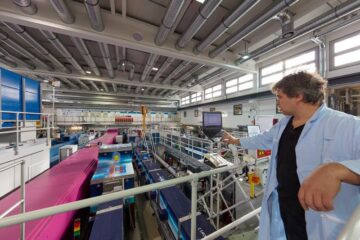Animals’ Chronic Stress Has Life-Long Consequences

Wild animals may suffer something akin to post-traumatic stress disorder in environments with both little food and many predators, says University of Toronto research.
The study, published in this month’s Proceedings of the Royal Society, highlights the complex relationship between chronic stress and song sparrow reproduction and survival. The study tested the hypothesis that the never-ending tension between finding food and avoiding predators affects the individual at such a fundamental physiological scale that the effects of food and predators on reproduction and survival are virtually inseparable.
„Kill or be killed combat stress can have life-long consequences for humans,“ says Professor Rudy Boonstra of the Centre for the Neurobiology of Stress and Department of Zoology at the University of Toronto at Scarborough. „Wild animals experience something similar daily having to find food while avoiding being killed by predators.“
Boonstra, his post-doctoral colleague, Michael Clinchy, Liana Zanette of the University of Western Ontario, John Wingfield of the University of Washington and Jamie Smith of the University of British Columbia conducted a two (fed versus unfed) by two (high versus low predator pressure) experiment on 91 song sparrow territories near Victoria, B.C. Using mist-nets, they captured fathers with six-day-old nestlings, collected blood samples from a wing vein, and then released them unharmed. Data was also collected on the number and condition of each dad’s nestlings.
Both food and predators affected corticosterone levels (the principal stress hormone in birds, acting in concert with adrenaline), free fatty acid levels (the energy molecule used for flight), anemia and nestling number and condition. The researchers found that unfed, high predator pressure birds had the highest stress levels, birds subject to either the unfed or high predator pressure treatments showed intermediate stress levels, and fed birds at the low predator pressure sites showed the lowest stress levels.
„Since the constant tension between finding food while avoiding predators likely afflicts virtually every bird and mammal the stage was set to use song sparrows to test the ’chronic stress’ hypothesis,“ says Boonstra.
The hypothesis was first proposed by Boonstra to explain synergistic (more than additive) effects of food and predators on snowshoe hare populations. In an earlier study, Boonstra and others showed that while reducing predator pressure doubled hare densities and adding food tripled densities, doing both led to an 11-fold increase. The hare study ended, however, before Boonstra’s hypothesis could be tested. In 2003, Zanette published the first study showing comparable synergistic effects in a bird, the song sparrow.
„The fact our new song sparrow data fit predictions from the snowshoe hare study so well suggests this is very general,“ says Boonstra. „If this is very general then targeting both food and predators may not only be key in conserving threatened species, but could also provide disproportionate benefits per dollar spent given the more than additive responses shown in both sparrows and hares.“
The study was funded by the Natural Sciences and Engineering Research Council of Canada and the U.S. National Science Foundation.
Media Contact
Weitere Informationen:
http://www.utoronto.caAlle Nachrichten aus der Kategorie: Studien Analysen
Hier bietet Ihnen der innovations report interessante Studien und Analysen u. a. aus den Bereichen Wirtschaft und Finanzen, Medizin und Pharma, Ökologie und Umwelt, Energie, Kommunikation und Medien, Verkehr, Arbeit, Familie und Freizeit.
Neueste Beiträge

Porosität von Sedimentgestein mit Neutronen untersucht
Forschung am FRM II zu geologischen Lagerstätten. • Dauerhafte unterirdische Lagerung von CO2 • Poren so klein wie Bakterien • Porenmessung mit Neutronen auf den Nanometer genau Ob Sedimentgesteine fossile…

Transparente emissive Mikrodisplays
… für ultraleichte und kompakte Augmented-Reality-Systeme. Im Rahmen des Projektes HOT („Hochperformante transparente und biegbare Mikro-Elektronik für photonische und optische Anwendungen“) haben Forschende des Fraunhofer-Instituts für Photonische Mikrosysteme IPMS ein…

Mikroplastik im Meer: Neue Methode
Mikroplastik im Meer könnte größtenteils auch aus Beschichtungen sowie Farbanstrichen von Schiffen und Bauwerken im Meer stammen. Daten dazu gibt es allerdings kaum. Das Helmholtz-Zentrum Hereon und das Bundesamt für…





















